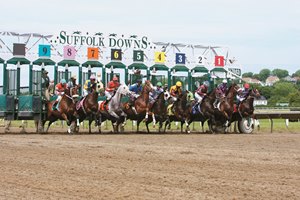Suffolk Downs Will Have Live Racing in 2018


As Suffolk Downs concluded a successful 2017 live racing season of eight days Oct. 1, the pressing question on the minds of many was whether live racing would return next year to New England.
The answer is in the affirmative.
The management team of Sterling Suffolk LLC, which now leases the racing and simulcasting operation from the major real estate development company that purchased Suffolk Downs in May, submitted its application for six live racing dates next year to the Massachusetts Gaming Commission by the Oct. 1 deadline as required by state statute.
But The Stronach Group, which was in conversations with the George Carney about renovating the family-owned former greyhound track at Raynham Park to potentially host a 30-day Thoroughbred meet there next year, passed on the opportunity to jump into the New England market.
"The Stronach Group did not submit an application, and Suffolk applied for six days," MGC spokesperson Elaine Driscoll confirmed.
Chip Tuttle, the chief executive officer of Suffolk Downs, said, "It's great that we're able to keep going, even in a limited capacity. We applied for the six days over three weekends of live racing over three months. But we've already had some conversations with the horsemen about potentially running more than that. But some of that is out of our control."
Since the implementation of the Massachusetts expanded gambling act of 2011 and the establishment of the Race Horse Development Fund, which is fueled by a percentage of revenue from the casino industry, purse money and dates are allocated by the regulatory MGC. The development fund, which supports both the Thoroughbred and Standardbred industries, contains millions of dollars and grows monthly.
During the 2017 season, Suffolk applied for and was originally granted six days of live racing, but then the track and the New England chapter of the Horsemen's Benevolent and Protective Association went back and requested the additional funding for the two days that were added to the schedule.
"We feel very fortunate that we were able to race this year and to add the additional two days to help so many horsemen and breeders and put money in their pockets," said NEHBPA President Anthony Spadea. "With so many tracks facing a shortage in their horse populations, we at first thought adding that fourth two-day weekend would be tough to fill. We are grateful for the overwhelming support we received from the former New England horsemen who came back to race here, and we are grateful to the out-of-town horsemen who ran their horses at Suffolk Downs this year."
Over the eight-day season, Suffolk offered purses that averaged about $500,000 per day plus incentives. Trainers received a $400 bonus for each starter, owners got a $500 participation bonus for horses finishing in the first five positions or a $1,500 runner's reward for horses finishing from sixth to last.
In 2017 there was an average of 10.4 races per card and the average field size was 8.2 horses per race. Those figures do not include the schedule of $50,000 stakes races that were restricted to Massachusetts-breds. Handle and attendance figures were not available.
"The point over the last couple of years is for us to provide a venue for the horsemen to run for some of this money which is building up in the Race Horse Development Fund. While it's great that people pay attention to the races and there are full fields and the racing is competitive, the meets have really been a way to extend our workforce and keep some operations going at the property while we look toward the next phase," Tuttle said.
Another high point of the meet is the 100% safety record for the jockeys and horses. Since Suffolk Downs was denied a casino license by the MGC in 2014 and switched to a six-day meet in 2015-16 and the eight-day meet in 2017, there has not been a single breakdown on the main track or turf course.
"The track maintenance crew at Suffolk Downs deserves a round of applause and a great deal of praise," said Spadea. "They are all unsung heroes."
Though Suffolk Downs, which opened in 1935, is committed to live racing in 2018 and the lease with the new property owners was extended, next year's live meet will be the last.
"I really can't see any possibility of live racing beyond next year," Tuttle said. "After 2018 we are hoping to continue as a simulcast-only facility on-site, or if that's not available, then somewhere else. We've had conversations with the horsemen, who are pursuing their own facility somewhere else in the state about that."
The NEHBA is continuing its efforts to fund and develop an equine center and racetrack in another part of the state that would be owned and operated by the horsemen. Spadea said there are currently four sites remaining under consideration and officials in each municipality remain favorable to the project.
In related news, the MGC last week voted unanimously to approve the request from the Massachusetts Thoroughbred Breeders Association to run up to nine state-bred restricted races and one Massachusetts-bred stakes race at Finger Lakes this fall. The MTBA told the commission it would also like to run a Massachusetts-bred race at a track in the Mid-Atlantic region.
In 2015, Massachusetts law was changed to allow state-bred races to be run out of state and they have been held at Finger Lakes since.
